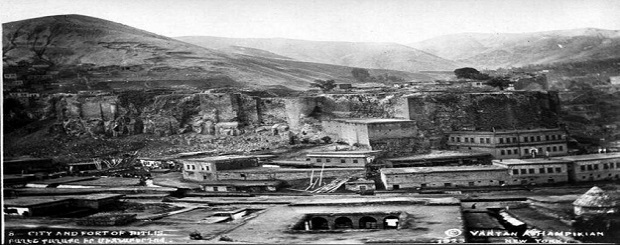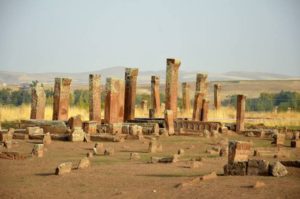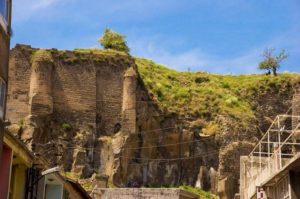
HISTORICAL PAGES – ART-A-TSOLUM – Bitlis, Cities of Armenia – Բիթլիս or Bagesh – Բաղեշ – a city in Western Armenia
VIGEN AVETISYAN – FEBRUARY 11, 2022 – HISTORY – PREVIOUS ARTICLE:
Bitlis – Բիթլիս or Bagesh – Բաղեշ – a city in Western Armenia, at present is the center of the Turkish silt of the same name. The area corresponds to part of the provinces of Aldznik and Turuberan of Greater Armenia.
The city is located at an altitude of 1600 m above sea level, about 20 km southwest of Lake Van, south of the Zorapahak Pass (Զորապահակ), at the confluence of the mountain rivers Havekhu (Hameghajur, Համեղաջուր), Khosrov (Amidol), etc., forming the river Bitlis – one of the tributaries of the Tigris.
The city is located in a valley into which rivers flow, and on the surrounding steep slopes, forming a huge amphitheater. Houses on the slopes are arranged in rows one above the other. In summer, the city is immersed in the greenery of gardens.
The foundation of Bitlis is attributed to Alexander the Great (4th century BC). According to legend, the city was built on his behalf by General lis, whose name was called “Evil lis” or “Petlis”. Previously, one of the springs gushing in the central part of the city was named after Alexander.
In ancient times, Bitlis was an Armenian city known as Baghesh (Բաղեշ), Baghaghesh (Բաղաղեշ) and under other names. In Armenian literature, the city is mentioned by Sebeos (7th century). Some historians believe that Bitlis was the main city of Salmadzor Agdznik’s gavar, while others classify Bznunik Turuberan’s gavar as one of them.
Its location almost at all times was convenient in terms of trade and military strategy, which contributed to the growth of the city.
Since ancient times, one of the largest roads connecting Trabzon, as well as large cities of central Armenia – Artashat, Dvin, Ani, Kars, Karin – with Mesopotamia passed in the valley of the Bitlis River. Under the Artashesids, the famous Arquni road passed here, connecting Artashat and Tigranakert.
Bitlis was conquered several times: in the 7th century, it was owned by the Arab conquerors, in the 10th century by the Byzantines. At the end of the same century, power in the city passed to the Kurdish tribes, who formed a khanate (or emirate) here.
The Kurds retained the power to varying degrees until the middle of the 19th century, except a few decades of conquest by the Seljuks (12th century) and the Kara Koyunlu (15th century).
In the 16th century, the Ottoman Turks took possession of Bitlis, however, having coped with several Turkish attacks, the Bitlis forced them to accept their internal autonomy, led by Kurdish leaders.
In the XVII-XVIII centuries. the city suffered significantly as a result of constant clashes between the Kurdish tribes. The indigenous population of the city of Bitlis and dozens of Armenian villages were forced out.
The autonomy was liquidated by the Turkish government in 1849 after the sack of Bitlis by Turkish troops. On the former territory of the khanate, the Bitlis vilayet was founded, which did not enjoy any autonomy.
At the end of the 19th century and the beginning of the 20th century, the area of the vilayet was more than 27 thousand square kilometers.
The Kurdish historian, statesman, and military figure Sharaf Khan ibn Shamsaddin Bidlisi (1543 -1603/04) wrote: “The majority of the population of the city [Bidlis] are Armenians.” In 1878-79. The population of the vilayet was about 400 thousand people, of which 250,000 were Armenians.
At the end of the century, the population was 382,000, of which 180,000 were Armenians. However, the Muslim population (mainly Kurds) already prevailed in the city of Bitlis. According to the data of the Armenian Patriarchate of Constantinople, in 1880, 10,724 Armenians lived in the city of Bitlis.
According to official Turkish data, at the beginning of the 20th century, the Armenian population here was 14-15 thousand (out of 40 thousand).
In 1894–96, pogroms and robberies were perpetrated in all the Armenian populated quarters of Bitlis. About 1000 Armenians were slaughtered in the city of Bitlis. Many were forcibly converted to Mohammedanism.
However, until 1915 Armenians remained the largest ethnic group in the vilayet. During the Genocide, the Armenian population of the city of Bitlis was completely exterminated.
In the Bitlis Kaz alone, 15,000 Armenians were killed. The pogroms were carried out by units of the regular Turkish army under the direct supervision of the governor of Van, Jevded. A small part of the Armenian population that escaped death found refuge in Eastern Armenia.
by Alexander Bakulin


allinnet.info/history/bitlis-cities-of-armenia/?
